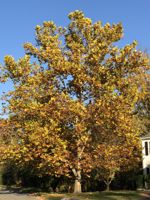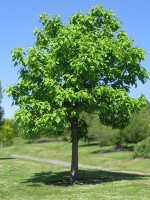Mon-Fri 9am - 5pm Mountain time
American Sycamore vs Northern Catalpa (Cigar Tree)
Platanus occidentalis
Catalpa speciosa
NOT AVAILABLE THIS SEASON - MIGHT RETURN
NOT AVAILABLE THIS SEASON - MIGHT RETURN
American Sycamore is the largest tree native to eastern North America. Generally too large and messy to be a street tree, American Sycamore thrives in large, open spaces, such as an acreage or farm.
The bark is one of the main features that draw people to this tree. The outer bark flakes off in irregular pieces to reveal an attractive white, green, and cream colored inner layer, providing winter interest.
American Sycamore has an extremely fast growth rate, gaining up to 6 ft in one year, and will easily reach its mature height in a short period of time. Be wary of this trees' root system, as it's typically very extensive and needs lots of room to expand.
Northern Catalpa is a striking feature tree with showy flowers, and very large leaves. Its orchid-like flowers are white with yellow and purple accents, and they have a pleasant fragrance. They bloom from late spring to early summer and can last up to two weeks, attracting hummingbirds and pollinators. The leaves are very large, ranging from 15-30 cm long, 12-20 cm wide, forming a canopy that makes it a good shade tree.
They can tolerate dry conditions as well as standing water, air pollution, and salt. These factors and its beauty contribute to its growing popularity as both a boulevard and ornamental tree in colder areas.
Northern Catalpa produces long bean-like capsules and are sometimes called the Cigar Tree in reference to this fruit.

